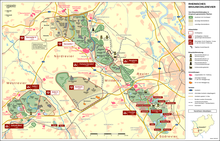Opencast mining future
| Basic data | |
|---|---|
| State : | North Rhine-Westphalia |
| Expansion: | 2300 ha |
| geographer. Location: | 50 ° 51 '18 " N , 6 ° 16' 27" E |
| Approved extension: | ? Ha |
| Coal content: | 530 million tons |
| Annual amount of spoil: | ? Million t |
| Annual coal production: | ? Million t |
| Coal-overburden ratio: | 3.5: 1 (?) |
| Approved operating time: | 1910 to 1987 |
| Resettled people: | approx. 2,925 |
| Residual hole: | Replenishment to the Blausteinsee |
The open pit future was an open pit of Rheinbraun AG for the production of brown coal between Eschweiler and Aldenhoven in the Rhenish lignite mining area .
history
Beginnings
1910 saw the start of lignite mining in the Eschweiler area by BIAG Zukunft . The future opencast mine between Eschweiler and Hehlrath took place on November 4, 1935, with a bucket wheel excavator being used for the first time in the western mine area and on February 21, 1938 at the start of lignite mining there. In November 1939 the road between Eschweiler and Hehlrath and the tram route Eschweiler – Hehlrath – Alsdorf were relocated. Because of the fighting during the Second World War , the Zukunft opencast mine came to a standstill in October 1944. The coal stick caught fire and burned until August 1945. Furthermore, the operating facilities were largely destroyed.
After 1945
On February 1, 1946, BIAG Zukunft resumed funding. From 1971 to 1973, the Rheinisches Landesmuseum Bonn collected and registered archaeological finds on the Aldenhovener Platte at Rittergut Hausen . The manor was demolished on May 14, 1976 and partially rebuilt on fire .
In November 1973, the recultivation of the opencast mine on the western edge had progressed to the Kinzweiler Castle . On the other hand, the Catholic church in Fronhoven , built in 1904 as a branch church of the Lohn parish , was demolished in the eastern part in April 1974 . In 1984 the 12 residents of Fronhoven-Ost were resettled.
On November 10, 1983, a landslide occurred at the edge of the opencast mine in the Dürwiß recreational area , in which around two hectares of land, hiking trails, the mini golf course and 200 meters of works road slipped into the opencast mine.
End of lignite mining
The end of lignite mining in the Eschweiler area took place on September 3, 1987, after the Zukunft-West opencast mine had produced a total of 530 million tons of lignite. On January 26, 1983, when the end of the opencast mine was already foreseeable, Aldenhoven, Alsdorf, Eschweiler and Würselen founded the sponsoring company for the Blausteinsee , which arose from the remaining open pit .
Resettled localities
| Resettlement sites | people | Dismantling year |
|---|---|---|
| Boring | 369 | 1972 |
| Laurenzberg | 363 | 1972 |
| Langendorf | 250 | 1977 |
| Velau near Hehlrath | 217 | 1953 |
| Fronhoven-West | 162 | 1979 |
| Upper pain | 107 | 1972 |
| Turk | 105 | 1965 |
| Good house | 21st | 1976 |
| Warden East | 20th | 1966 |
| Fronhoven East | 12 | 1984 |
See also
literature
- Materials for primary school: The Rheinische Braunkohlenrevier - K. Chavet, M. Chavet, A. Müller, H. Rademacher, Rheinbraun 1988, ISBN 3-926732-02-4




